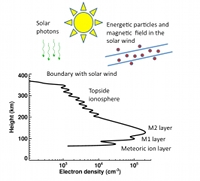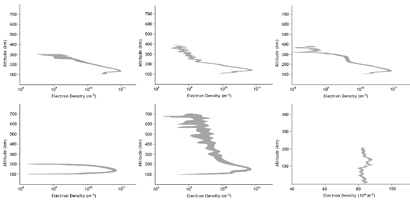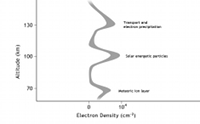New views of the Martian ionosphere
15 November 2012
High above the main body of Mars' atmosphere is a region of weakly ionised gas, known as the ionosphere. For the last eight years this poorly understood region has been observed by instruments on board ESA's Mars Express orbiter, and new studies show that the dayside ionosphere is more variable and more complex than previously thought.The ionosphere is a key part of the boundary between the planet's lower, neutral atmosphere and the charged particles of the solar wind. This zone of interaction results in the formation of free electrons which reflect radio waves, a property which noticeably impacts communications between Mars and Earth. Detailed knowledge of the Martian ionosphere is also crucial in evaluating the importance of atmospheric escape for the evolution of the planet's climate and its habitability over time.
 |
|
Dayside ionosphere of Mars. Image courtesy of P. Withers, Boston University |
Rather than being uniform throughout, the Martian ionosphere has been found to have a stratified structure, with two main layers. The highest electron densities are found at an altitude of about 140 km, where extreme ultraviolet light from the Sun ionises the neutral atmosphere. Electron densities above this layer generally decrease with increasing altitude. A secondary layer, which occurs at approximately 120 km, is produced by "soft" X-rays from the Sun and associated impacts with energetic electrons.
The composition and behaviour of the Martian ionosphere also differ over time and according to their geographical location. Atomic oxygen ions are most common at higher levels, while molecular oxygen species are more common at lower altitudes. These changes are caused by large variations in the solar wind, atmospheric dynamics and composition, and by the patchwork pattern of the crustal magnetic field.
One of the key objectives for scientists is to understand how competing physical processes produce the observed state of the ionosphere. Although its basic structure has been pieced together over many years by means of observations from Mars Express, as well as numerous US and Russian spacecraft, many questions have remained.
However, two new studies by international teams of scientists are now providing a more detailed view of the ionosphere. These studies are based on observations made with the Mars Express Radio Science (MaRS) experiment led by Martin Pätzold of the University of Cologne,
The MaRS experiment uses a technique called radio occultation, which can be applied when the spacecraft disappears behind the planet, as seen from Earth. As the radio signals that are transmitted between the spacecraft and Earth pass through the Martian ionosphere, they reveal information about how the concentration of electrons varies with altitude.
A recent paper in Geophysical Research Letters shows that the vertical structure of the day-side ionosphere of Mars is more variable and more complex than previously thought. A second paper, published in the Journal of Geophysical Research, reports on new results about the structure and variability of the night-side ionosphere, which is less well known.
Since 2004, MaRS radio occultations have resulted in more than 500 vertical profiles of the dayside ionosphere between altitudes of 60 km to 800 km, with a vertical resolution of 0.5 km. The data show that the top of the ionosphere can drop below 250 km, but occasionally rise above 650 km. Graphs showing the vertical electron density of the ionosphere's main layer sometimes have a sharply pointed, flat or wavy shape, in contrast to its usual smooth, curved shape.
 |
|
Dayside and night-side profiles of the Martian ionosphere. Credit: ESA/ AOES Medialab |
A broad increase in electron density is sometimes detected at 160-180 km, while a narrow layer of raised electron density is sometimes found in localised, but strongly magnetised regions, and an additional layer is occasionally present between the two main layers.
"These observations show that the Martian ionosphere is a lot more variable than I expected," said Paul Withers of Boston University, lead author of the two papers. "Many of these features have not been predicted and it will be interesting to see how theorists attempt to explain them."
Without sunlight to split atmospheric atoms and molecules into ions and electrons, the night-side ionosphere of Mars is very different from the dayside. Electron densities are much smaller and relatively little is known about the vertical structure of the night-side ionosphere. However, the unprecedented quality of the MaRS experiment has enabled scientists to examine the night-side ionosphere better than ever before.
The MaRS experiment obtained 37 electron density profiles of the night-side ionosphere between 18 August and 1 October 2005. In the early evening, electron densities were found to decrease with time after sunset, consistent with the theory that ionospheric plasma was supplied by transport from the sunlit dayside.
 |
|
Night-side ionosphere of Mars. Credit: ESA |
This trend ceased about two hours after sunset, when the Sun was well below the horizon. Deeper into the night, peak altitudes of 130-170 km were measured, consistent with plasma production by impacts from electrons travelling down magnetic field lines - a process known as electron precipitation.
During solar energetic particle events, plasma densities were enhanced at low altitude and peak altitudes could be much lower than usual, at about 90 km.
"These observations of the night-side ionosphere show just how confusing and complicated it is," said Paul Withers. "There is no consistent shape to its vertical structure, and the relative importance of plasma production by transport from the dayside and by electron precipitation are unclear."
"Sometimes there is almost no plasma at all in the night-side ionosphere. We expect these behaviours to be influenced by the unique crustal magnetic fields of Mars which affect the night-side ionosphere. We hope to explore this interaction as soon as we can get observations from the strongly magnetised regions of Mars."
"This study sheds new light on the variability of the ionosphere, a layer which affects radio propagation," said Olivier Witasse, ESA's Project Scientist for Mars Express.
"In particular, the operations of the Mars Express radar are strongly affected by the presence of an ionosphere, which is why it operates mainly on the night side. Any mission to Mars using radio signals for science observations needs to know how the ionosphere behaves. When a manned mission is sent to Mars, it will be important to know the state of the ionosphere in order to optimise communications to and from Earth, as well as on the surface."
Notes for editors
Mars Express was launched in June 2003 and became ESA's first visit to another planet in the Solar System. The scientific payload, provided by research institutes throughout Europe, consists of seven instruments that provide remote sensing measurements of the atmosphere, ground and below the surface. Since arrival in orbit around Mars in December 2003, Mars Express has been helping to answer fundamental questions about the geology, atmosphere, surface environment, history of water and potential for life on Mars.
The Mars Radio Science Experiment (MaRS) uses radio waves to study both the surface and the atmosphere of Mars. It measures local variations of gravity over the surface of the planet as well as providing pressure and temperatures profiles of the atmosphere. The experiment relies on the observation of the phase, amplitude, polarisation, and propagation times of radio signals transmitted from the spacecraft and received at ground station antennas on Earth.
Contacts
Paul Withers
Astronomy Department, Boston University
Massachusetts, USA
Email: withers bu.edu
bu.edu
Phone: +1-617-353-1531
Martin Pätzold,
Rheinisches Institut für Umweltforschung, Abt. Planetenforschung
Cologne, Germany
Email: Martin.Paetzold uni-koeln.de
uni-koeln.de
Phone: +49-221-27781810
Olivier Witasse,
Mars Express Project Scientist
Research and Scientific Support Department
Directorate of Science & Robotic Exploration
ESA-ESTEC, The Netherlands
Email: Olivier.Witasse esa.int
esa.int
Phone: +31-71-5658015

